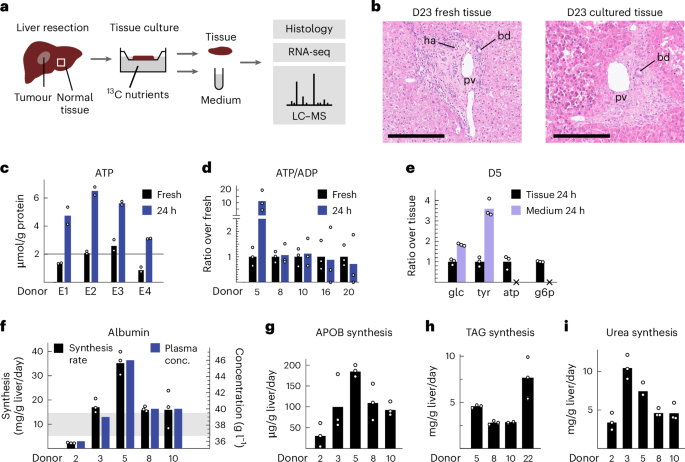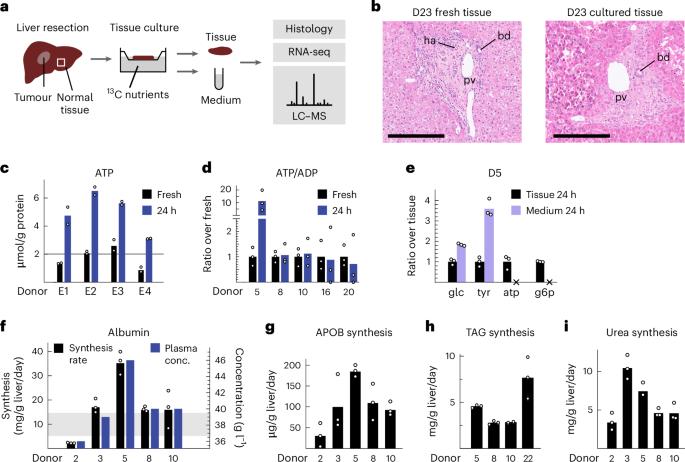Global 13C tracing and metabolic flux analysis of intact human liver tissue ex vivo
IF 18.9
1区 医学
Q1 ENDOCRINOLOGY & METABOLISM
引用次数: 0
Abstract
Liver metabolism is central to human physiology and influences the pathogenesis of common metabolic diseases. Yet, our understanding of human liver metabolism remains incomplete, with much of current knowledge based on animal or cell culture models that do not fully recapitulate human physiology. Here, we perform in-depth measurement of metabolism in intact human liver tissue ex vivo using global 13C tracing, non-targeted mass spectrometry and model-based metabolic flux analysis. Isotope tracing allowed qualitative assessment of a wide range of metabolic pathways within a single experiment, confirming well-known features of liver metabolism but also revealing unexpected metabolic activities such as de novo creatine synthesis and branched-chain amino acid transamination, where human liver appears to differ from rodent models. Glucose production ex vivo correlated with donor plasma glucose, suggesting that cultured liver tissue retains individual metabolic phenotypes, and could be suppressed by postprandial levels of nutrients and insulin, and also by pharmacological inhibition of glycogen utilization. Isotope tracing ex vivo allows measuring human liver metabolism with great depth and resolution in an experimentally tractable system. Grankvist et al. combine global isotopic tracing and metabolic flux modelling to characterize metabolic networks in human intact liver tissue.


体内完整人体肝脏组织的全球 13C 追踪和代谢通量分析
肝脏代谢是人体生理的核心,影响着常见代谢性疾病的发病机制。然而,我们对人体肝脏代谢的了解仍不全面,目前的大部分知识都是基于动物或细胞培养模型,不能完全再现人体生理。在这里,我们利用全球 13C 追踪、非靶向质谱法和基于模型的代谢通量分析,对完整人体肝脏组织的体内代谢进行了深入测量。通过同位素追踪,可以在一次实验中对多种代谢途径进行定性评估,证实了众所周知的肝脏代谢特征,同时也揭示了一些意想不到的代谢活动,如从头合成肌酸和支链氨基酸转氨酶,人类肝脏在这些方面似乎与啮齿类动物模型有所不同。体内葡萄糖的产生与供体血浆葡萄糖相关,这表明培养的肝组织保留了各自的代谢表型,并可被餐后营养素和胰岛素水平以及糖原利用的药物抑制所抑制。体内同位素追踪可以在一个易于实验的系统中对人体肝脏代谢进行深度和分辨率测量。
本文章由计算机程序翻译,如有差异,请以英文原文为准。
求助全文
约1分钟内获得全文
求助全文
来源期刊

Nature metabolism
ENDOCRINOLOGY & METABOLISM-
CiteScore
27.50
自引率
2.40%
发文量
170
期刊介绍:
Nature Metabolism is a peer-reviewed scientific journal that covers a broad range of topics in metabolism research. It aims to advance the understanding of metabolic and homeostatic processes at a cellular and physiological level. The journal publishes research from various fields, including fundamental cell biology, basic biomedical and translational research, and integrative physiology. It focuses on how cellular metabolism affects cellular function, the physiology and homeostasis of organs and tissues, and the regulation of organismal energy homeostasis. It also investigates the molecular pathophysiology of metabolic diseases such as diabetes and obesity, as well as their treatment. Nature Metabolism follows the standards of other Nature-branded journals, with a dedicated team of professional editors, rigorous peer-review process, high standards of copy-editing and production, swift publication, and editorial independence. The journal has a high impact factor, has a certain influence in the international area, and is deeply concerned and cited by the majority of scholars.
 求助内容:
求助内容: 应助结果提醒方式:
应助结果提醒方式:


